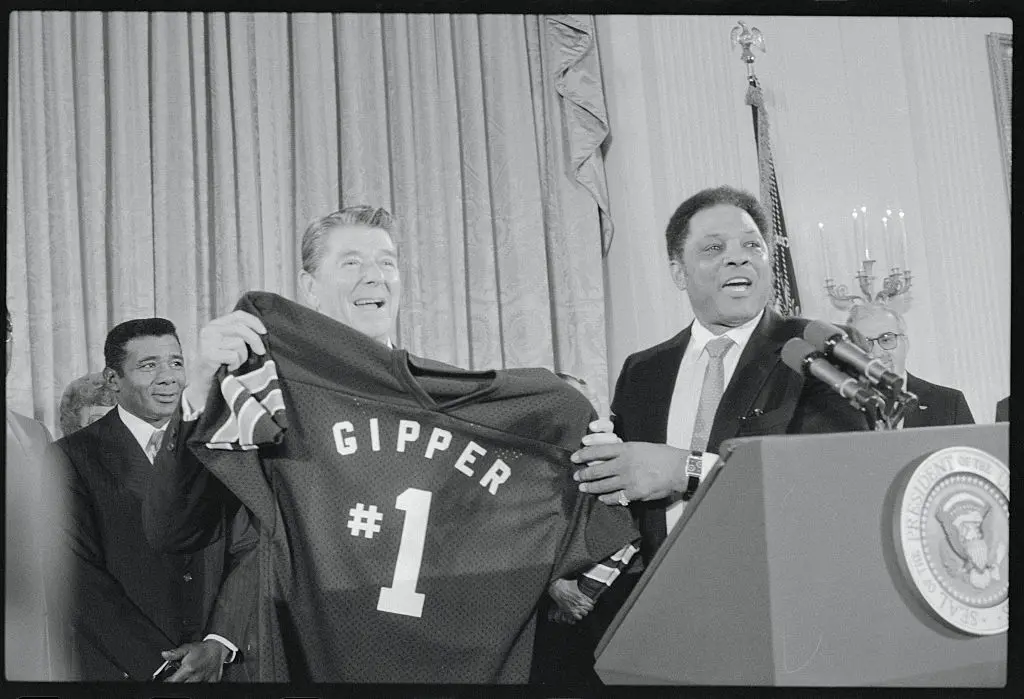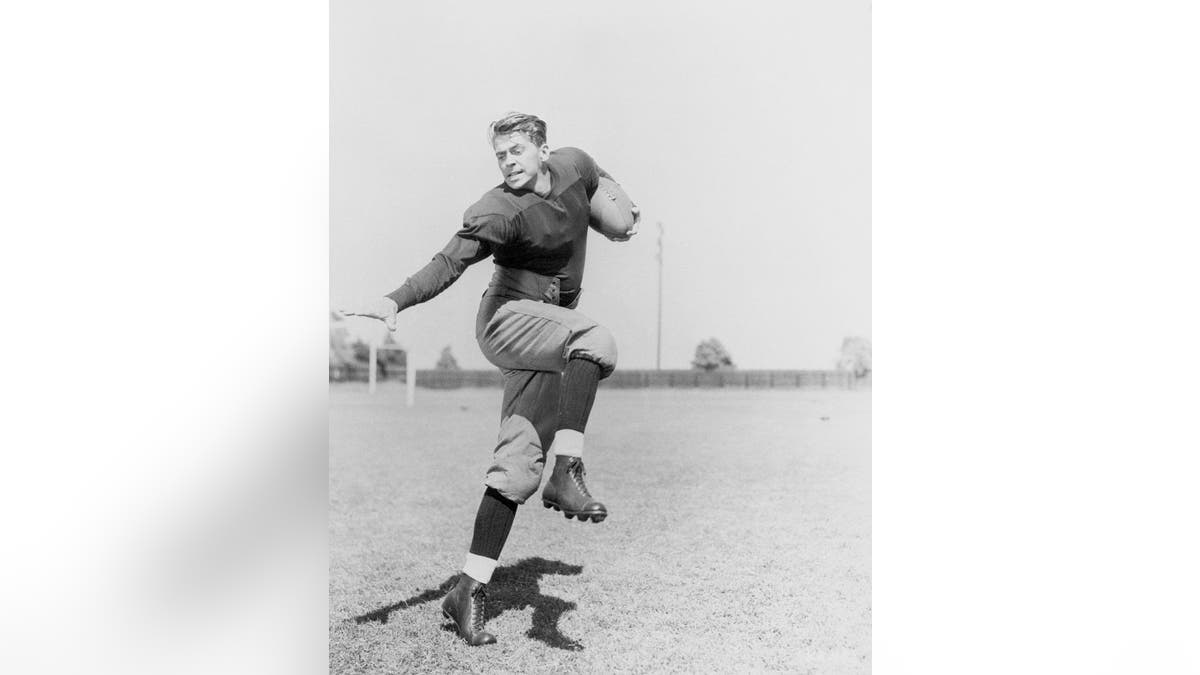
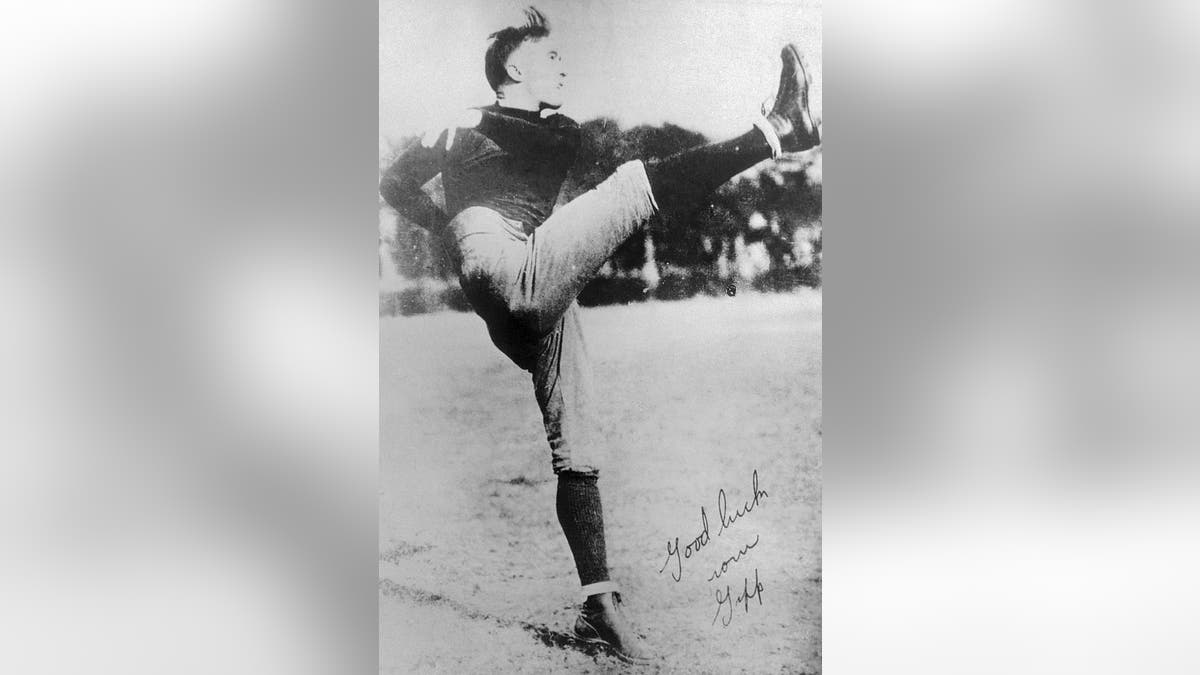
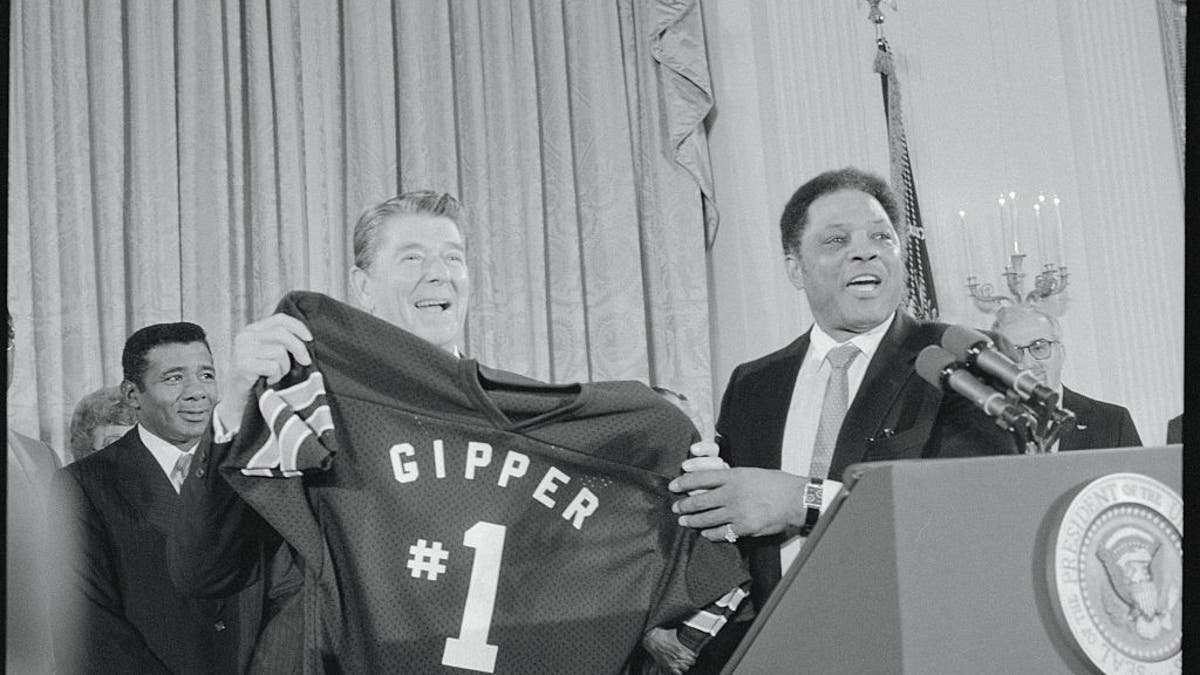
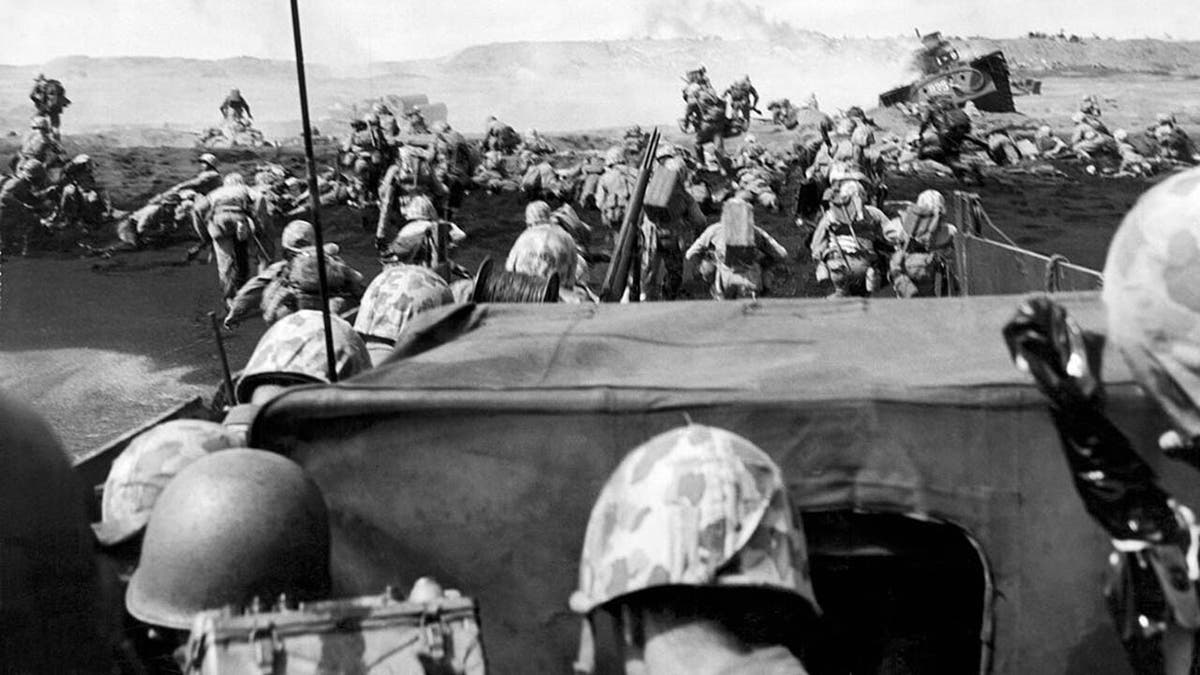
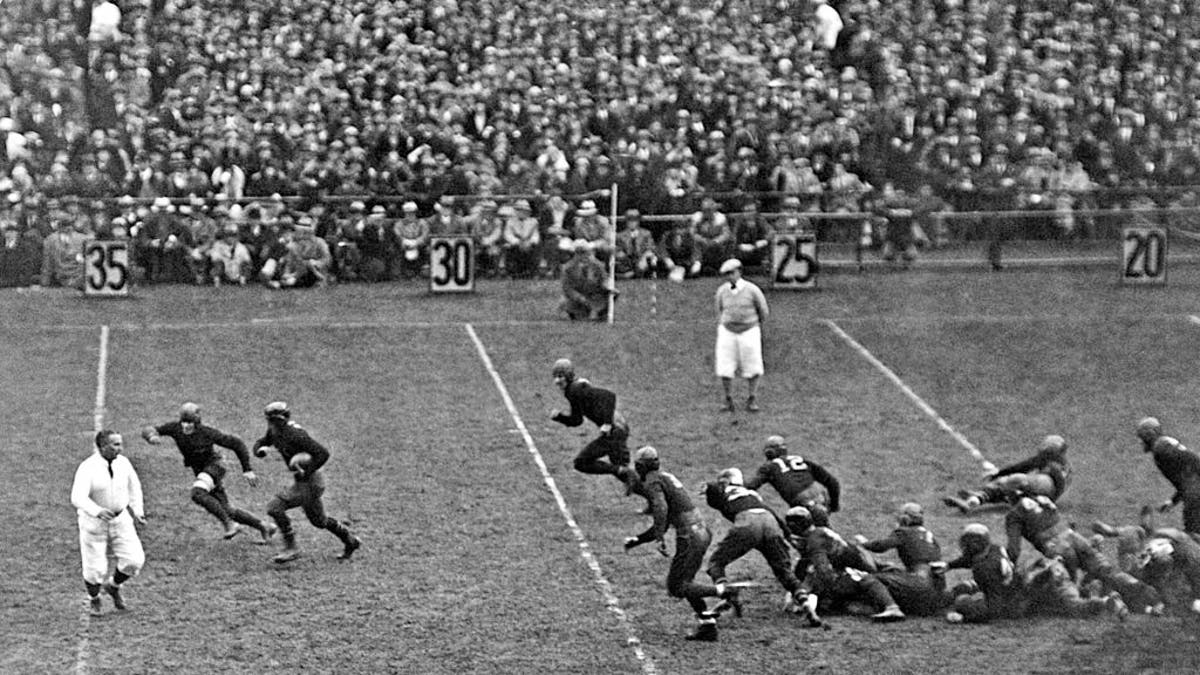
The Notre Dame football team, inspired by late gridiron star George Gipp and the most famous halftime pep talk in sports history, rallied to upset undefeated Army in front of 85,000 fans at Yankee Stadium on this day in history, Nov. 10, 1928.
Legendary head coach Knute Rockne’s impassioned “Win one for the Gipper” speech echoed through the decades — far beyond the football field — and entered American cultural, political and military lore.
The struggling 1928 Notre Dame squad, newly dubbed the Fighting Irish a year earlier, scored two second-half touchdowns to come from behind and stun the powerful Cadets, 12-6.
“Rockne was trying to salvage something from his worst season as a coach at Notre Dame,” the University of Notre Dame archives note.
Rockne lost only 12 games in 13 seasons as Notre Dame’s head coach — four of them in 1928. Army had dominated on its way to a 6-0 start that year and had lost only two games since 1925.

Ronald Reagan is shown here as he appeared when he played George Gipp in the 1940 Warner Brothers film, “Knute Rockne, All American.” (Getty Images)
“To inspire the players, [Rockne] told them the story of the tragic death of the greatest player ever at Notre Dame, George Gipp,” the University notes.
“The Gipper” was the all-purpose star of Rockne’s dynamic early 1918-1920 teams; he was famous for his hard-living lifestyle off the field and his dominance on it.
Gipp suffered pneumonia at the end of the 1920 season and died suddenly that year, on Dec. 14.
The strapping Michigan native, who excelled at running, passing and kicking, was just 25 years old.
His alleged deathbed request of Rockne for the team to win a game in his memory entered the American pop culture lexicon when it appeared in the star-studded 1940 movie, “Knute Rockne: All American.”
Hollywood leading man Ronald Reagan played Gipp.

George Gipp, football player for Notre Dame, is shown here in action. The autograph reads, “Good luck from Gipp.”
“I haven’t got a complaint in the world, Rock. I’m not afraid,” the future president whispered from his bed into the ear of the coach, played by Pat O’Brien, portraying the final hours of Gipp’s life.
He then implores the coach with 1940s Hollywood melodrama, as Rockne holds his hand: “Rock, some day when the team’s up against it and the breaks are beating the boys, ask them to go in there with all they’ve got and win just one for the Gipper.”
“George Gipp was a man I had always admired.” — Ronald Reagan
Reagan cherished the role, adopted the “Gipper” nickname in his later political career and was known to use “Win one for the Gipper” as a campaign rallying cry.
Gipp was “a man I had always admired” and “one of the greatest football players of all time,” the actor wrote years later in a piece for the Saturday Evening Post.
The real-life Rockne waited eight years — sickly and confined to a wheelchair — for the right moment to spring the tale of the Gipper’s supposed last wish on his overmatched team.

President Reagan holds a shirt given to him by former baseball star Willie Mays after Reagan spoke to campaign workers at the White House. “Gipper, #1,” refers to a movie role Reagan played during his Hollywood days, in which he was a football star named George Gipp. (Getty Images)
“Men, this is that day! Let’s go!” star Notre Dame halfback Jack Chevigny reportedly shouted as the Irish stormed out of the locker room after hearing Rockne’s impassioned plea, according to several accounts.
Whether Gipp’s deathbed request was real or not, the tactic worked brilliantly.
The inferior Fighting Irish roared back to overcome a 6-0 deficit and shock Army.
MEET THE AMERICAN WHO FIRST COMMANDED THE MARINES: REVOLUTIONARY WAR HERO SAMUEL NICHOLAS
“That’s one for the Gipper!” Chevigny yelled after scoring a touchdown to tie the game at 6-6.
Chevigny later became a Notre Dame assistant and NFL and college head coach. He was the head coach of the University of Texas when the Longhorns shocked Notre Dame, 7-6, in 1934.

Fourth Division Marines charging from their landing craft onto the beach in the battle at Iwo Jima, Japan. Jack Chevigny, the star of Notre Dame’s legendary “Win one for the Gipper” game, was a U.S. Marine Corps officer killed on the first day of battle on Iwo Jima, Feb. 19, 1945. (Photo by Underwood Archives/Getty Images)
He went on to greater heroics off the field.
Chevigny joined the Marine Corps in 1943 as a 37-year-old officer. He was killed on Feb. 19, 1945, on the first day of combat on Iwo Jima.
The legend of the “Win one for the Gipper” game followed the war hero into death.
Tales swirled for years that he carried with him a cherished souvenir pen, given to him after Texas beat Notre Dame, with an inscription dedicated to his victory over his alma mater.
CLICK HERE TO SIGN UP FOR OUR LIFESTYLE NEWSLETTER
The legend claims the pen was taken off his body by an enemy solider and that it appeared in the hands of a Japanese officer aboard the USS Missouri during surrender ceremonies in Tokyo Bay on Sept. 2, 1945.
The tale has been largely debunked, but it speaks to the impact of the game on the identity of the men it immortalized.

Jack Chevigny of Notre Dame makes a 25-yard gain in the game against Army at Yankee Stadium in New York on Nov. 10, 1928. Earlier, Knute Rockne gave his famous, “Win one for the Gipper” speech — and when Chevigny later scored a touchdown to tie the game, he said, “That’s one for the Gipper.” Notre Dame won, 12-6. Chevigny was killed on Iwo Jima in World War II. (Photo by Underwood Archives/Getty Images)
There are real examples of the game’s impact on American military history: Gipp, Rockne and Reagan all had U.S. Navy ships named in their honor.
The SS Gipp and SS Rockne were Liberty Ships that served in World War II.
The USS Ronald Reagan, a nuclear-powered super-carrier, patrols the world oceans today in defense of America.
The 1928 Notre Dame-Army game was the biggest sporting event in America that year, played in New York City and covered by the top reporters of their era, such as Damon Runyon.
CLICK HERE TO GET THE FOX NEWS APP
The “Win one for the Gipper” legend has come to overshadow the sporting spectacle that unfolded at Yankee Stadium that day.
“Even without the subsequent Gipper mythology, it was considered one of the greatest college football games ever played,” Sports Illustrated reported in 2014.
For more Lifestyle articles, visit www.foxnews.com/lifestyle.
Kerry J. Byrne is a lifestyle reporter with Fox News Digital.
[ad_2]
Source link

